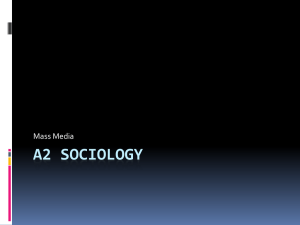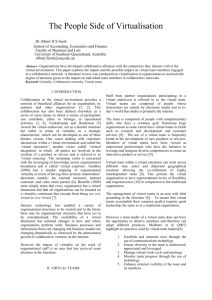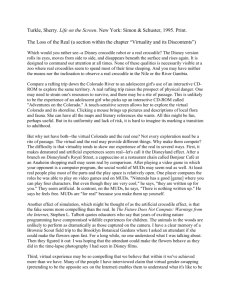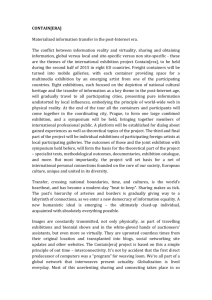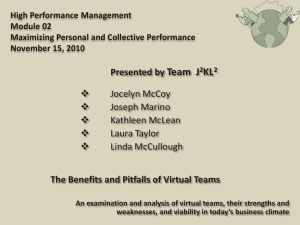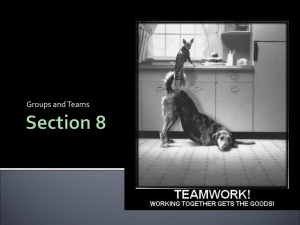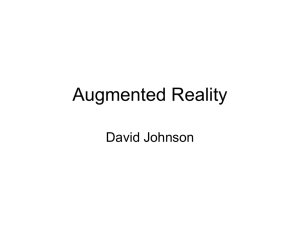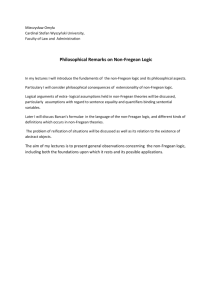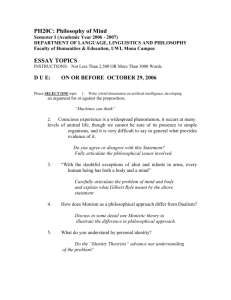There are numerous descriptions on the virtual reality (VR) which try
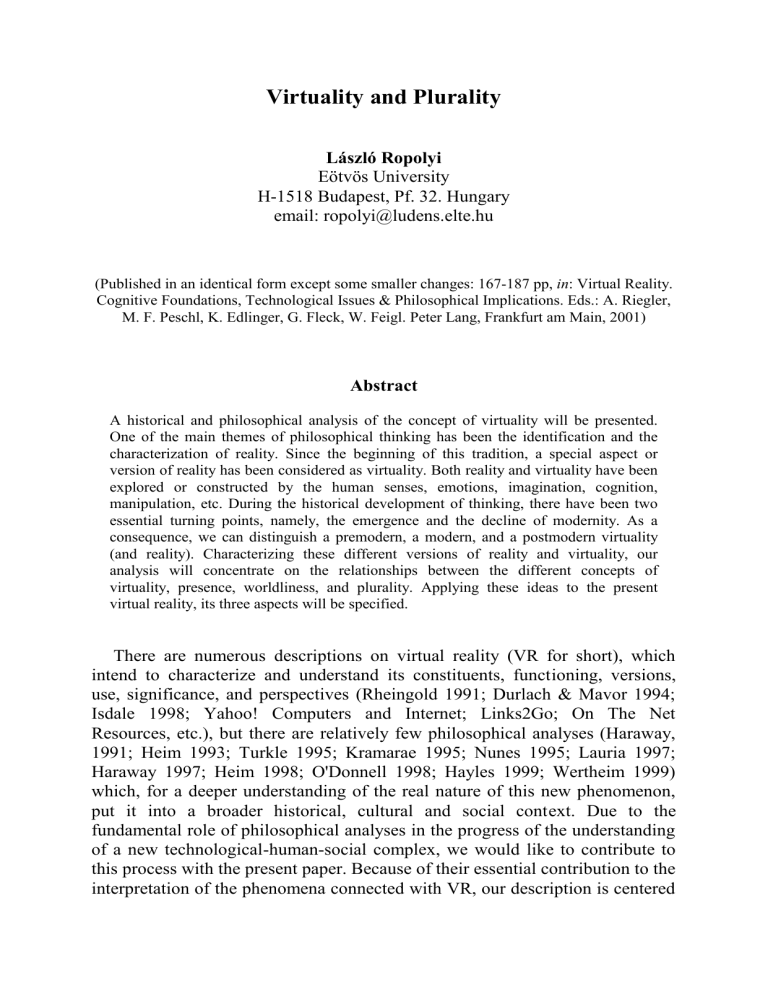
Virtuality and Plurality
László Ropolyi
Eötvös University
H-1518 Budapest, Pf. 32. Hungary email: ropolyi@ludens.elte.hu
(Published in an identical form except some smaller changes: 167-187 pp, in : Virtual Reality.
Cognitive Foundations, Technological Issues & Philosophical Implications. Eds.: A. Riegler,
M. F. Peschl, K. Edlinger, G. Fleck, W. Feigl. Peter Lang, Frankfurt am Main, 2001)
Abstract
A historical and philosophical analysis of the concept of virtuality will be presented.
One of the main themes of philosophical thinking has been the identification and the characterization of reality. Since the beginning of this tradition, a special aspect or version of reality has been considered as virtuality. Both reality and virtuality have been explored or constructed by the human senses, emotions, imagination, cognition, manipulation, etc. During the historical development of thinking, there have been two essential turning points, namely, the emergence and the decline of modernity. As a consequence, we can distinguish a premodern, a modern, and a postmodern virtuality
(and reality). Characterizing these different versions of reality and virtuality, our analysis will concentrate on the relationships between the different concepts of virtuality, presence, worldliness, and plurality. Applying these ideas to the present virtual reality, its three aspects will be specified.
There are numerous descriptions on virtual reality (VR for short), which intend to characterize and understand its constituents, functioning, versions, use, significance, and perspectives (Rheingold 1991; Durlach & Mavor 1994;
Isdale 1998; Yahoo! Computers and Internet; Links2Go; On The Net
Resources, etc.), but there are relatively few philosophical analyses (Haraway,
1991; Heim 1993; Turkle 1995; Kramarae 1995; Nunes 1995; Lauria 1997;
Haraway 1997; Heim 1998; O'Donnell 1998; Hayles 1999; Wertheim 1999) which, for a deeper understanding of the real nature of this new phenomenon, put it into a broader historical, cultural and social context. Due to the fundamental role of philosophical analyses in the progress of the understanding of a new technological-human-social complex, we would like to contribute to this process with the present paper. Because of their essential contribution to the interpretation of the phenomena connected with VR, our description is centered
around the concept of virtuality with a special emphasis on the relations between the concepts of virtuality and plurality.
If we try to identify the object of our present analysis, one of the most accepted definitions of VR is the following: "Virtual reality is a technology that convinces the participant that he or she is actually in another place by substituting the primary sensory input with data received produced by a computer ... The 'as-if' quality of virtuality becomes a pragmatic reality when the virtual world becomes a workspace and the user identifies with the virtual body and feels a sense of belonging to a virtual community. The definition of
VR includes the three key factors of immersion, interactivity, and information intensity." (Heim 1998, p. 221). On the basis of this (or a similar) definition
(and incidentally with a complete harmony of the public opinion), one can think that VR is a very new phenomenon, since it is closely linked to the computer technology of the last few decades. However, this is not completely true.
Moreover, it can be shown that in the history of culture VR has had many earlier (not computer-related) versions. The study of these old (or at least more traditional) VRs can contribute to the better understanding of the specific nature of the present-day, computer-produced VR.
On the other hand, we can find a large number of studies not only about virtual reality , but also about virtual space (or cyberspace), virtual community, virtual self, virtual culture, virtual world, virtual activity, virtual picture, etc., and even about virtual physics or virtual computers. It seems to be a hidden presupposition that in all these cases the attribute "virtual" refers more or less to an identical concept of virtuality. Let us cite again Heim's vocabulary: " Virtual:
A philosophical term meaning 'not actually, but as if.' It came into recent vogue with the use of computer techniques to enhance computer memory ... Similarly, something can be present in virtual reality without its usual physical limitations.
The ancient Roman term virtus , from which virtual derives, meant the powers of a human being. The later Christian meaning of 'virtue', as Nietzsche pointed out, inverted the Roman value system and eliminated the overtones of power".
(Heim 1998, p. 220) This explanation is perhaps an acceptable starting point, but a further clarification of the meaning of 'virtual' seems to be necessary and a historical and philosophical analysis of the nature of virtuality would perhaps be useful to the better understanding of virtual "something" and the virtuality of virtual reality, as well.
In the first part of this paper, accepting a rather naive and flexible concept of virtuality, we shall outline a (very) brief history of VR. In this history three different versions of virtuality (premodern, modern, and postmodern) will be distinguished and characterized. Referring to these historical versions of virtuality in the second part of the paper, we shall present a short philosophical analysis to show the special role of presence, world-making, and plurality for a better understanding of virtuality. Finally, applying the results of our analysis,
we shall conclude with a characterization of the scientific, art-related and philosophical aspects of the present-day VR.
The Historical Aspects of Virtuality
It can be stated without any doubt that one of the main themes of philosophical thinking has been the identification and characterization of reality . In this tradition the reality can be described as the complete collection of beings, as the realm of existence, as the world, or as a specific realm of beings in the world which is discovered (or created) by human senses, emotions, imagination, cognition, manipulation, production, etc. Of course, our choices between these (and many further) alternative approaches and perceptions of reality depend on our value systems, ie on our ideological preference. The nature and the borders of reality, a valid demarcation between the real and the non-real (apparent, imaginary, irreal, fake, non-existing, meaningless, etc.) as the fundamental questions of ontology have been the permanent sources of ideological and philosophical debates. The specificities of virtuality and virtual beings can be originated from this intellectual context. The fundamental problem is the right characterization of the versions of the reality-virtuality relationships.
It is quite obvious that reality can be considered as the totality of beings. In this case, we have to understand the nature of beings and the nature of totality.
For this understanding we have to make a decision about the appearance of unity and plurality in and of the beings, and in their totality, as well. Based on these presuppositions, every single being and its unique universe can be described as a specific unit, as a complete whole, as an organized system especially if we are able to disclose their appropriate organizing principles, the organizing principles of reality . However, if we accept the Heideggerian criticism of the above mentioned metaphysical tradition, and prefer the existence of Being to that of the beings, our task will change, but not in every respect. After this turn it will also be necessary to find a description for the structure and organization of Being as reality.
In search for the organizing principles of reality, we shall follow a partly hermeneutic and partly social constructivist approach. According to this view, in a specific historical period, all the characteristic elements of a specific world system of a period are imbued with almost the same system of values and interests (ideology, for short). These ideologies emerge from the socio-historical situation of the given society and they define in large the essential aspects of the construction of different kinds of entities. (Berger & Luckmann 1966)
Considering and comparing the different regions of beings in a society, it is possible to identify and describe the common rules of construction and find the
preferred organizing principles of the age. Of course, this is valid in the cases of reality and virtuality and their relations, too. In short, we could say that we shall try to contribute with some ideas to the social construction of virtuality .
However, in this construction process there have been two essential historical and ideological turning points at the emergence and at the decline of modernity, so we can speak about premodern, modern and postmodern reality and virtuality.
Premodern Virtuality
The premodern period had many, although slightly different ideas concerning the reality-virtuality problem. In the magic world view it is not very easy to point out a significant distinction between reality and virtuality. The magic reality was constructed by will, in this way the mere construction of interrelations between the observed phenomena or between the experienced situations had an absolute primacy, without making any distinctions between different kinds of interrelations (these distinctions appeared later on, in the mythical world views). In the magic views, the possibility and the actuality of a relationship are coextensive with each other, reality and virtuality overlap each other, they are indistinguishable aspects of the world. In other words, the indistinguishability of reality and virtuality is a fundamental feature of the magic world view. The magic virtuality is virtuality as reality . As an illustration, we could recall the praxis of the Shamans. According to some interpretations, the Shamans’ activities can be compared to the activities of certain artists in cyberspace. (Jones 1997).
When philosophy emerged from the mythological world view, the early distinctions in the evaluation of the relationships of experienced situations had a more fundamental significance. In addition to this development, the structure of human experiences, the composition of beings, the complicated functioning of cognition, the levels and hierarchy of existing entities were studied and disclosed by the first philosophers. This progress produced the ideas of the plural world (inhabited by essentially different beings, which may even exist at different levels of the Being) or a plurality of worlds (each of which is inhabited by fundamentally different beings). The different kinds of modes of existence have become a topic of intellectual debates. In this context some definite differences between the different kinds (or levels) of reality can be established and treated. The fundamental question is: how can we identify and reach the parts of our experience or knowledge, which are unquestionable, which are real in full, which yield to doubtless certainty. These parts of knowledge refer to the inner core of reality, which is surrounded by less valuable spheres of reality.
These outer spheres seem also to be a part of reality for the people who are not
learned enough or who are not critical enough in their observations and/or thinking. For a philosopher their full reality is only appearance, which can be destroyed by careful observations or the right arguments. The sphere of reality of which the full reality is proved to be ephemeral in the light of the philosophical investigation is the sphere of virtuality, itself. The ancient reality should be an eternal reality; whereas the ancient virtuality the kind of reality, which is able to loose its full reality. (It is quite obvious that the significance of ephemera can also be observed in the present-day versions of VR.)
Already in the early ancient Greek philosophy, two main traditions were formed to investigate the phenomena of our life, to criticize them, to produce certainty and to approach the real in full. These are the traditions of the ancient
"materialism" and that of the Parmenidean one. According to the "materialist" tradition, reality can be based on the testimony of our perception. In this tradition the main problem is the right coordination and evaluation of the different sensual experiences. In ancient literature there are many interesting argumentations and debates around this problem, eg in the works of Heraclitus,
Aristotle, or Theoprastus. As Paul Feyerabend emphasized, there happened a radical turn in the human culture with Parmenides, who rejected the testimony of senses in the question of reality and proposed the use of right (and contradiction-free) thinking as a judge in this respect. Because of the perceptual illusions and the ephemeral feature of any perception, Parmenides declared all the sensual experiences to be appearances. Since that time there has been a dual tendency in Western culture: reality can be constructed following the tradition of compared sensual experiences or the tradition of right thinking. These traditions yield to different kinds of realities and virtualities.
As an illustration, it is perhaps interesting to recall some problems from the ancient natural philosophy, namely, the different interpretations of motion, void, or atoms. Within the framework of the Parmenidean tradition, for example, supposing the real existence of motion, Zeno presented contradictionary consequences. In this way he rejected the reality of motion. However, this result does not get confirmed by our everyday perceptual experiences, so this radical disharmony between the realities created by thinking and by perception is called paradox . Paradoxes can be considered to be the signs of the appearance of virtuality in the Parmenidean tradition.
There is not enough room here to discuss the contributions of the philosophical systems of Plato and Aristotle to this problem in detail, however, they are very significant.
Plato's two worlds (the imperfect sensual world and the perfect world of ideal Forms) represent the spheres of virtuality and reality in a very clear form.
The sensual world is a realm of change and impermanence. It is a complete world, however, it has a lower value compared to the true, fully real world of
Forms. The world-forming Platonic virtuality is an ephemeral and contingent
reality which is an imperfect copy of the true reality. In this world knowledge has a strict limitation. If we are restricted to use our experiences we can only form different opinions about the sphere of virtuality, and it is impossible to reach the absolute truth here.
Aristotle's main contribution to the problem was perhaps his teaching about the clear distinction between the two levels of Being, namely between the actuality and the potentiality. The actual being is a being in full, and the potential being lacks fullness, so they are good candidates for the Aristotelian reality and virtuality. However, according to the Aristotelian thinking, both the actual and the potential being are due to every entity, which means that reality and virtuality are distributed among the beings of our world instead of their concentration into completely separate worlds. In this way the Aristotelian virtuality is an individual property of entities. On the other hand, Aristotle described and analyzed the transformation of potentiality to actuality and vice versa and he interpreted the concept of motion in this way. This means that both the Aristotelian reality and virtuality have a dynamism, they can transform to each other, so the Aristotelian virtuality has a changing nature .
The Middle Ages presented a further version of premodern virtuality. While in the ancient time the construction of reality and virtuality was performed by the senses or right thinking, in the Middle Ages the reality and virtuality were created by emotions, primarily by the religious belief. In this era both the perception and the thinking played a subordinate role. Perception was considered as a typical source of illusion. The most perfect reality, God, had no perceptible aspects (however, the idea of the Trinity as one God created a rather complicated situation in its details); he was accessible only by strong emotional efforts. The world was inhabited by creatures at different levels of perfection and in the hierarchy of beings (eg think of the arguments of the realismnominalism debate). The life of human beings is performed in the "vale of tears", in the shade of the world. In this way the medieval virtuality had many common features to the Platonic one, but it had a more complex structure arranged along a gradual hierarchy of perfectness. The complete earthy life takes place in the realm of virtuality or in other words, everything is virtual in some sense - the only exception is God. From this point of view, the miracles
(similarly to the ancient paradoxes) had a very specific ontological state: they were considered as a direct appearance of the divine will, that is, they disclosed the full reality in the realm of virtuality .
In summary, we could say that the different versions of premodern virtuality were the dominant components of premodern ontologies. The typical premodern ontology depicted a plural world or the plurality of worlds. In both cases reality is a structured construction, and its constituents have different grades or measures of certainty, perfectness, contingency, permanence, value, etc. A constituent, a part, or a version of reality, which has no maximal measure in
socially given reality-determining factors, or which is able to loose its maximal value can be considered as virtuality.
Premodern virtuality is a kind of reality, it can be an uncertain, or an imperfect, or a contingent, or a changeable etc. reality. The premodern reality is an open reality, it is open for constructing many possible worlds by virtualizing different components of reality.
Modern Virtuality
The emergence of modern ideology and world view created a radically new context for ontological thinking. This is the age of the formation of the modern individual, the autonomous personality. Because of the historical conditions of this process, the fundamental aspiration of the modern individual was to gain the ruler position over his world (Fromm 1969). The medieval God-world relation has been reproduced in many individual forms. However, the modern individual wanted to wield a real, unquestionable, certain, effectively functioning power, that is, he/she wanted to rule over a full reality. As a result of these developments, the basic structural elements of the power situation have been considered as reality in full, such as the individual, his/her power, and the object of this power (nature, the other individual, property, etc.). For the other constituents or aspects of the collection of beings a lower reality-measure was allocated, they constituted the sphere of virtuality around "the secret object of desire". (Thanks to Buńuel.)
During the development of modernity the distinction between the objective and the subjective reality became possible and significant. The distinction between these possibilities ie the declaration as full reality of the 'external' or the 'internal' world of the perceptive human beings lead to the second fundamental schism in the ontological tradition (similarly to the emergence of the Parmenidean tradition in the ancient time). These controversial tendencies created the formation of modern materialism and subjective idealism, which are two different positions in many respects. However, the most important feature for our current analysis is the fact that in these traditions the active, determinant elements of the power structure are different. In the materialist tradition the
'external' world, the nature, the society, the body, the objects of our power are the active agents of the situation, while in the subjective idealist tradition the
'internal' world, the individual abilities (perception, intentionality, thinking, will, etc.), play the determinant role. However, the intermediate element in the structure of modern power, the acting power, is common in both traditions.
It is rather evident that the active, determinant compositions of the basic structures of modernity can be considered as reality in full, so from this point of view some aspects of the modernist traditions can be different. The creatures of both of these active power-elements (the constituents of the mental world or
from the point of view of the other tradition, the constituents of the 'outer' world) without any doubt have a contingent nature, so they only have a contingent reality, ie they belong to virtuality. However, the modernist, active reality can only appear in operation, so the active elements and the acting power are definite parts of reality.
The modern personality has a plural nature. Following the materialist tradition, this plurality seems to be the realm of virtuality with apparent individual ideologies, beliefs, goals, life-histories, etc. immersed and performing in the only real world. This is a plural, internal virtuality built up into the only one, external reality. Both of them are created by using scientific experiences and clear rational thinking. The modernist sciento-technological methodology of this creation is a methodology of power, which can be characterized as a selfish methodology (Ropolyi 2000). The non-scientific methodologies of everyday life, art, and religion are only able to construct virtuality (eg naive views about the natural processes, works of art, religious praxis), so their roles in the modern society are strongly limited. (A widely accepted evaluation of the significance and possibilities of the present-day VR -
Heim calls it as "naive realism of the Unabomber" (Heim 1998, Ch. 2) - is based on a very similar ideology.) As an illustration we can refer to the French philosophy in the eighteenth century.
Following a subjective idealist tradition, the plurality of individuals apparently means the plurality of reality, but in its consequent, solipsist, version, we have to go as far as the virtuality of others, ie we arrive again at a plural virtuality. This is a plural external virtuality, built up into the only one internal reality. The methodology of these kinds of constructions is practically the same as it was mentioned at the description of the materialist tradition, but it is applied to a "soft", less known and studied praxis. This is an important field for cognitive science, too. (There is another common opinion about the presentday VR - Heim calls it "idealist" - which is based on a similar ideology.)
Perhaps the Leibnizian monads which represent individuals in a way, or
Berkeley's philosophy would illustrate this tradition in the history of ontology.
Summarizing the main ideas about the modern virtuality, it can be stated that in the modern era we can find only one full reality, which is the 'external' or
'internal' world - they are the realms of the objective and the subjective reality.
The virtual possible worlds were transformed into the inside of personality and became an important source for its individual and plural character. Earlier we mentioned the perfectness, the certainty, etc. as the determinant characteristics of reality compared to the virtuality, now we would like to add the power, the active, creative force as a feature of reality to this list. Modern reality is able to create and control itself and to develop its structure in a self-organizing process.
In this respect modern virtuality is a reality which is created, which has no absolute power, or which was able to loose it and which is forced to suffer from
the use of power . Modern reality and virtuality form closed, individualized worlds together in order to ensure an absolutely controllable environment for the individual beings.
Postmodern Virtuality
Postmodern ideology is a critical reflection of the failure of the modernist ambitions, first of all, in respect of power. It became transparent that the realization of the modernist power and the effective control over the individualized worlds have unavoidable disadvantages and intransgessable bounds. In this situation postmodern thinkers have described two strategies for the present-day ideology. According to some people the deliberation from any ruler ambitions would be an acceptable exit from the modern crisis, but for many others the presentation of that kind of behavior would be the solution in which the successful operation of the modernist project is demonstrated. They are the strategy to disregard the power and the strategy to disregard the bounds.
Concerning their difference from the modernist view, both alternatives represent the same, in their images of reality and virtuality.
The fundamental postmodern ideal is a so-called decentered ontology, in which the boundary between reality and virtuality is destroyed. There is not one reality or there is no reality at all, we can only speak about hyperreality
(Baudrillard 1994; Nunes 1995). In the world of hyperreality the distinction between real and unreal is blurred. In this world the images and signs, the simulations and simulacra have no referents, they can only be considered as real beings. In this situation (which is approaching the last stage of a cultural crisis) the image masks the absence of reality and substitutes its place. It makes no sense to speak about external and internal worlds, about materialist and idealist constructions, because the construction itself is the definite, central part of the intellectual activity. The significance and the role of the place, the body, the distinguishable material and intellectual entities collapse, they become substituted by their interrelations and networks .
During the construction of the postmodern world view, the different possible worlds in the modern individuals got legitimized as natural and exclusive bases in the organization of the complete world view. In this way the postmodern world has a necessarily plural nature. Perhaps it could be stated that the postmodern world view in respect of the relation to reality-virtuality simulates the images of the magic world view about the question. The postmodern view about reality and virtuality is an individualized (and evidently plural) simulation of its magic ideals.
It is possible to accept a less radical image of postmodernity. In this way of thinking, the postmodern world can be considered as a complex of the modern
world and its critical alternatives. In this view modernity is able to preserve its coherence, but is unable to preserve its dominant position; it is just one of the many alternative systems of value. This less radical alternative does not change our images of reality and virtuality fundamentally, however, this version of postmodern thinking simulates the mythological rather than the magic ideals about reality and virtuality.
The postmodern reality/virtuality is created, perhaps, by imagination, which is a specific and concrete mixture of perception, will, and reason and it has a strongly individualistic nature. The postmodern world is open to include everything and to exclude (the) nothing. The postmodern personality is an inflating personality, its extends world wide without gaining more weight.
In short, the postmodern virtuality can be described as reality and vice versa.
This situation is created partly by a radical proliferation of reality, and partly by the disappearance of the reality-virtuality boundary. So there is no boundary between reality and virtuality, moreover they have basically lost their independent meaning and it would be better to substitute both of these concepts with something else, perhaps with the concept of hyperreality. This means that instead of reality or virtuality the construction itself is significant for the postmodern person.
Our quick overview of the history of ontology in respect of virtuality sheds light on the various ideological contexts of the concept of virtuality and its outcomes constitute the historical backgrounds for the philosophical analysis presented below.
The Philosophical Aspects of Virtuality
As a result of a traditional philosophical investigation, if it is careful enough, the real nature of the subject can be disclosed. In our case during this kind of analysis, the distinctions between the real and the virtual characteristics of virtuality became clearer and clearer and finally we could ‘tell the reality’ about virtuality. Perhaps this strategy would be recommended in the investigation of most traditional problems in cognitive science, however, it seems to be less popular in the treatment of the problems around present-day VRs, where more intuitive methods have been applied recently. Supposing that this practice is more reasonable, let us try to combine the traditional and the intuitive methodologies.
Overviewing the historical collection of virtualities, it is almost clear that virtuality is either a kind of, or a constituents of, or an aspect of, or a part of, or a feature of reality. In the usual context these characteristics of virtuality are not clearly distinguishable, they regularly overlap each other. For example, we can speak about the virtual communities as a kind of virtually existing reality, and at
the same time we can identify the virtual constituents of a community in both virtual and real communities. There is no room here for a detailed analysis of all the relevant aspects of the problem, so the following part of our paper will focus only on those features of virtuality which play a fundamental role in the understanding of present-day VR. The three fundamental cooperating families of concepts or conceptual fields are the following: the concepts expressing some aspects of presence, world-formation, and plurality.
Presence and Virtuality
According to the commonly held opinion, presence has a fundamental role in the existence of virtual reality. (Lombard & Ditton 1997; Lauria 1997; Stanney,
Mourant & Kennedy 1998; Schuemie et al. 2001) Lombard's and Ditton's explication of the concept is based on an extensive collection of ideas about presence, and it is the following: presence is "the perceptual illusion of nonmediation. The term 'perceptual' indicates that this phenomenon involves continuous (real time) responses of the human sensory, cognitive, and affective processing systems to objects and entities in a person's environment. An
'illusion of nonmediation' occurs when a person fails to perceive or acknowledge the existence of a medium in his/her communication environment and responds as he/she would if the medium were not there ... Presence ... cannot occur unless a person is using a medium." In this short definition the psychical and physiological aspects of presence are emphasized, but the authors propose to take into account its social aspects, as well. However, because of the primacy of the psychical elements in presence, some scholars say that
"psychology is the physics of VR." (Lauria 1997) From our earlier description it is obvious that presence should have to play a fundamental role in the identification of reality and virtuality, as well, because both of them presuppose a kind of presence.
Characterizing the specificity of the existence of virtuality, Heim (1993) used the term "erotic ontology" to describe cyberspace experiences. (This is a very interesting idea in the sense as well that the erotic experiences of the everyday praxis have a close connection with the presence characterized above.)
A further analysis can show some other aspects of presence, for example, it makes clearer the relation between the personal and the social presence, between the full and the particular presence, and so on. (Schuemie et al. 2001)
There is a close (but not necessarily direct) connection between the kind of processing system acting in presence and the active, creative human force working in the creation of reality. Both the presence and reality are the product of many different processes, but the determinative factors of presence are basically correlated to the creative factors of reality . For example: presence
produced with the primacy of a sensory processing system constitutes the necessary condition for the creation of reality by perception. There is a similar relationship between the presence primarily presented by cognitive abilities and the reality created by reason or by thinking, and between the presence mainly based on instincts and the reality created by will.
At a first glance the person is the subject of presence, and a personal reality can be based on presence. However, there are strong historical arguments for the socio-cultural determination of the emergence and characteristics of the personality (Fromm 1969), including its abilities, perceptual, communicative, and creative preferences. (From a constructivist point of view, it would even be possible to recall Karl Marx's thesis about the historical evolution of human senses.) Moreover, there is a similar historical evolution of the human body : the ancient, the medieval, and modern bodies are essentially different entities.
Recently there have been many investigations on the cyborg identity, which is a humanized (or non-human or posthuman) coexistence of biological and technical elements in the human beings. (Haraway 1991; Heim 1993; Haraway
1997; Biocca 1997; Hayles 1999) In this way, if we declare the (embodied) person (with his/her personal body) to be the subject of presence, this subject will necessarily be a socio-culturally determined historical being and consequently his/her presence will have a similar nature. Any personal presence is necessarily a social presence. Most of the details of these problems are reflected in visions or elaborated in the theories of personality.
In the historical versions of reality and virtuality some relevant aspects of the socio-culturally determined historical presence can be shown. For example, the premodern virtuality as ephemeral, contingent, uncertain, imperfect, impermanent reality is based on a premodern version of presence. This presence has completely similar characteristics to those of the premodern virtuality as it can be illustrated by the situation of the observer in the Platonic cave. Another
Platonic approach to reality, which can reach the reality in full, is the remembrance of the soul to the world of Forms. This technology of reality demands a different kind of presence, which has a higher value or degree. It can be seen that even within the framework of one philosophical system there are different kinds of presences and they have different degrees or measures . These presences are experienced or created to establish and support accepted realityvirtuality interrelations; within the same context the higher degree of presence yields to reality in full, but the lower degree of presence yields to virtuality.
So far we have only discussed the concept of presence, but in the arts, in philosophy, and in some other fields of culture many, more or less synonymous concepts have been constructed, which can be used in the analysis of virtuality, as well. Just think of the Aristotelian actuality - potentiality concepts, of the arguments in the medieval debates between nominalists and realists, of the essential conceptual constituents of aesthetic theories, or of some categories of
the speech act theory, or the concept of immersion used in many descriptions of
VR, etc. One of the most relevant concepts is the Heideggerian Dasein , which can be considered to be a specific unit composed of humanity, of presence, of reality, and of virtuality, etc. There is no room for a detailed analysis, but it can be found elsewhere. (Dreyfus 1991; Heim 1993)
In summary, some kind of presence is a necessary condition for any kind of reality and virtuality. The different versions and degrees of presence experienced in a socio-culturally determined way coincide with the ideas on reality and virtuality. The recent VRs prefer a technologically supported perceptual illusion of nonmediation. In this kind of presence the human senses and imagination have to function in an artificial, or simulated environment.
Worldliness and Virtuality
There is no doubt that presence is necessary for the construction of reality and virtuality, but it is not enough. Pure presence, in absence of its - at least temporary or illusive - exclusiveness, unquestionability, and permanence, would be basically useless for construction. These characteristics ensure that one can form a complete unit from the experiences, which is called a unique system of reality; and can consider oneself as part of it. In other words, one can form a world around himself/herself. However, if the world-making is unsuccessful or incomplete from any point of view (the construction proves to be non-exclusive, questionable, impermanent) it will be declared virtuality instead of reality in full. This means that both reality and virtuality have (perfect and imperfect) worldliness characteristics.
Recently in philosophy there have been many interesting descriptions of the structure and formation of worldliness. All of them seem to be relevant to the better understanding of virtuality. The Heideggerian description of the worldliness of the world, of its components (world, inclusion, involvement,
Dasein, disclosing, etc.), and Heidegger's concept of "being-in-the-world" is analyzed carefully by Dreyfus (1991), moreover, Heim (1993) used some of their elements and motifs in his own interpretation of VR.
Another approach to worldliness can be found at Goodman. Cooper (2000) applied Goodman's criteria for ways of world-making in his interesting interpretation of MUD worlds. (According to the Goodmanian methodology, world making consists of the following practices: composition and decomposition, weighting, ordering, deletion and supplementation, and deformation.)
For Heidegger and Goodman, everyday human praxis has a fundamental role in their systems. Because of this preference of their constructions, it is very reasonable to apply them in the interpretation a fundamental aspect of present-
day VR. However, the present-day VR does not only have everyday-related, but some other aspects, too, and for their understanding we have to turn to other theories. For this purpose, we will turn to the aesthetics of Georg Lukács.
Mentioning the connection between the arts and VR is not a really surprising idea. Moreover, it is known that the term virtual reality came from the theory of the theater suggested by Artaud in the thirties of the twentieth century. (This interrelation returns also in the theatrical analogy of VR proposed by Wong
(1996).) Beside the theory of the theater, film theories and, of course, some more general aesthetic theories, and an extended praxis of artists (Jones 1997;
Heim 1998) can be considered as relevant context to understand VR.
In Lukács's aesthetics the work of art has worldliness quality. (Lukács 1963)
He used this concept to explain the "power" of the works of art on the senses of the recipients. With this "power" during the reception process, the work of art creates a different world for the recipient - different from the real, everyday world -, orient his/her immersion in this constructed world, in the own world of the work of art, convince him/her about the reality of this world, and govern his/her state and thinking in this way. Every work of art has its own world, which is complete and closed from the point of view of its inexhaustible richness. However, these worlds are open, as well, they are open to reception.
The worldliness of these worlds is supported by the homogeneous media of the work of art. The infinite richness of human reality is represented by a work of art using its homogeneous medium, constituted, for example, from the rhythm, the form, the colors, etc.
The Lukácsian conceptual structure seems to be very useful and effective in the description of the worldliness of VR. The operation of the "power" of the technological environment on the user, which ensures the perfect illusion of reality can be interpreted in a very similar way to the power of the work of art on the recipient. In this respect the "technology" of present-day VR and its manner of construction play the role of the construction rules of work of art.
The artists of the VR are the engineers and the computer scientists. The homogeneous medium is a technologically mediated presence. The works of art are some kind of totality, they represent the very essence of the human world.
The VR represents the everyday experiences of the human beings using the compositional requirements of art.
Realizing the fundamental role of technology in the VR worlds, the challenges of cyborg-existence, and the specificities of cyberspace, one can think that VR does not have any human, but rather a technological worldliness, ie it is organized by technological principles. However, based on our earlier discussion, we would advocate the opposite opinion. In the manner of the
Lukácsian aesthetics, this complex of problems (the human-machine coexistence in a technological environment) can be described as a process of the antropomorphization of technology, the technological products, and the
technical "space". Going further along a constructivist line, it could be said that the world of VR is not the world of humans nor the objective outside world, but it is an artificial production of the human-machine relation, a world of the human-machine complex. Directly, but not indirectly. Indirectly, it is a representation of the personality-society, the individual-other individuals, etc. relations, because the machines (including computers and other VR technics) embody social relations and values (eg think of Latour’s delegation idea), they are imbued with these values. (Latour 1993)
As a summary, it can be emphasized that presence and worldliness are correlated determinants of virtuality. They mutually support the functioning of each other. The worldliness of reality in premodern and modern virtuality appeared in such spheres of culture as art, religion, science and philosophy. The specificity of present-day postmodern virtuality is the dominance of senses and imagination in the construction.
Plurality and Virtuality
A kind of presence and worldliness of the experiences are necessary conditions for virtuality and reality, as well. However, if we want to identify the specificity of virtuality only we have to reconsider the reality-virtuality relation.
According to the historical tradition of ontology, reality should be considered as a unique entity , which covers the whole universe of beings. This is the concept of reality in full. If this reality is considered as a closed reality, there is no place for virtuality in this world. In this case everything is a specific constituent in the only one reality since within reality there are no different measures or degrees of reality. The differentiation of virtuality and reality becomes possible only with the image of an open reality . The openness means that a being is considered not only as actuality, but as actuality together with its potentialities.
(Ropolyi 2000) This means that an open reality can be considered as a complex of the reality in full and its numerous potential versions. (Of course, this is a very Aristotelian idea.) Considering the reality in full and its potentially existing versions together from a quantitative position, it can be stated that reality has a plural aspect: all of these different versions in a certain sense belong to the same reality, they can be counted as the numbers of the same. If we do not want to take into account the differences between the actual and the potential versions, we can speak about the proliferation or the plural nature of open reality.
However, if we focus on the differences between the actual versions and the potential versions, we can use the concepts of reality in full and ‘reality less than full’, ie virtual reality. In this way the concept of virtuality refers to a structured reality, a reality which is open, plural, and contingent.
According to the further analysis of the relation between actuality and potentiality, it could be seen that openness and virtuality are two conceptual formulations of this relation. While openness can be interpreted as actuality considered together with its possibilities, virtuality can be interpreted as potentialities together with their actualization . Openness is a feature of reality, virtuality is a feature of potentialities. They are inseparable from each other, their coexistence is the virtual reality. In this way VR is a reality together with its possibilities and possibilities together with their actualization, or shortly: VR is the actualization of the potentialities of an open reality.
The actuality-potentiality relation is a specific version of the general onemany relation . The one-many relation has had different treatments in the history of thinking, for example, monism, pluralism, reductionism, statistics, etc. In this respect the specificity of virtuality is the permanent transformation from the many to the one.
On the other hand, we can identify the transformations from reality to virtuality and vice versa, ie we can consider the reality and virtuality in motion .
There is no room here to treat the dialectics of these processes, so we just have two brief remarks. The realization of a possibility or the loss of the reality of a being are the very common courses of events. This is the case with VR, too.
Because of the above transformations, beside VR we can also speak about RV
(real virtuality). This is the postmodern category of simulacra.
The above mentioned plurality was associated with the open reality and its possibilities. However, further important appearances of plurality can also be identified in the problems of VR, for example, the use of plural contexts, the plurality of the personality (Turkle, 1995), and so on.
In short, it can be stated that virtuality cannot be interpreted without a plural reality. The plural reality is an open reality and its openness is deeply connected to its virtuality. Virtuality is a feature of the potentialities of an open reality and refers to the potentialities together with their actualization.
Based on the previous philosophical analysis, three aspects of VR can be differentiated: VR as VR, VR as the art of everydays, and VR as the sign of the social crisis.
Aspects of Virtual Reality
1. If we consider the VR as a field of study about presence in a synthetic environment, ie if we follow a scientific tradition we can find many interesting psychological, cognitive, social, and technological problems to solve. (Chenault
1998; Sempsey 1998; Stanney, Mourant & Kennedy 1998; Levine 2000; Preece
2000; Utz 2000; Ahuna 2001; Schuemie et al. 2001; Suler 2001) In this case the significant problems (eg the measurement and the characterization of presence)
are very similar to the traditional scientific problems and their treatment can follow this paradigm. In this case the modern virtuality has a dominant role in
VR.
2. If we turn our attention to the problems of worldliness in VR, ie if we try to disclose the relation between the arts and VR, we can speak about the VR as the art of everydays . Everyday art differs radically from traditional art, because it expresses directly the everyday experiences but in a form which is a form of art. The VR as everyday art applies the "technology of arts", but to express very common contents. It is true that there is no catharsis, but there is a very democratic praxis. This is an advantageous and an easy way to construct worlds for everybody. No specific abilities are necessary for this creating praxis, since technology can help us. This aspect of VR can be studied in the text mediated
MUD worlds (Fleissner, 1999; Cooper 2000; Utz 2000) and the worlds of
Avatars (O'Donnell 1998) and in general (Heim 1998). Concerning this aspect of VR, premodern virtuality seems to be the dominant one.
3. If we focus on the problems of plurality in VR, ie if we want to understand the philosophical and the social meaning of VR, we can realize that VR can be considered as a sign of social crisis . The permanent presence of the plural reality, the postmodern pluralization of the world view is a standard sign of the social crises. (Ropolyi 2000) In this situation one cannot create an acceptable and unquestionable unit from the many divergent values. There are different fields of the social reality where similar signs of crisis have appeared. Parallel to the development of VR, other (chemical) technologies of virtuality have also emerged. The use of drugs for virtual travels started to be accepted on the basis of the struggle of the beat movement against the accepted traditional value system. The beat movement can be considered as a virtual revolution. A hesitation between the utopic and antiutopic position of the eminent representatives of science fiction writers of VR (Gibson 1984) is a significant sign of the crisis. The play elements of culture (Huizinga 1938) become more and more significant.
The appearance of postmodern virtuality can be seen in the philosophical aspect of VR. As is well known, postmodernity is an ideology of a society in deep crisis.
The humanization of technology and the technicization of human abilities run in parallel ways to serve the evolution of the present-day cyborgs. (Agre,
1999) Following the VR ideology, the goal is to construct a synthetic (artificial) environment for real personalities, whereas in the research into artificial intelligence, an opposite trend is in function to construct an artificial personality for a real environment. The postmodern personality is pluralized with the hope for a new unit of privacy, identity, and intimacy on the net. (Unsworth 1995;
Munro 2001) A network society emerges in the cyberspace. Its ideology and
philosophy is rather unclear, however, as Lauria (1997) suggested, VR can be considered as a metaphysical testbed, so we are in the right track.
Acknowledgements
I thank Günther Fleck for the interesting discussions and for the invitation to the NTCS'01 - Virtual Reality conference. This project was partially supported by the Hungarian Research Fund (OTKA T 025 406).
References
Agre, P. E. (1999) Life After Cyberspace. EASST Review . 18(2-3): 3-5. or http://dlis.gseis.ucla.edu/people/pagre/life.html
(accessed 08. 03. 2000).
Ahuna, C. (2001) Online Game communities are social in nature. Switch 7(1): http://switch.sjsu.edu/v7n1/articles/cindy02.html
(accessed 28. 06. 2001).
Baudrillard, J. (1994) Simulacra and Simulation . Ann Arbor: University of
Michigan Press.
Berger, P. L. & Luckmann, T. (1966) The Social Construction of Reality. A
Treatise in the Sociology of Knowledge . New York: Doubleday et Company.
Biocca, F. (1997) The Cyborg's Dilemma: Progressive Embodiment in Virtual
Environments. Journal of Computer-Mediated Communication 3(2): http:// www.ascusc.org/jcmc/vol3/issue2/biocca2.html
(accessed 25. 04. 2000).
Chenault, B. G. (1998) Developing Personal and Emotional Relationships Via
Computer-Mediated Cummunication. CMC Magazine May 1998: http:// www.december.com/cmc/mag/1998/may/chenault.html
(accessed 07. 02.
2001).
Cooper, W. (2000) MUDs, Metaphysics, and Virtual Reality. The Journal of
Virtual Environments 5(1): http://www.brandeis.edu/pubs/jove/HTML/v5/ cooper.htm (accessed 28. 06. 2001).
Dreyfus, H. L. (1991) Being-in-the-World. A Commentary on Heidegger's Being and Time, Division I.
Cambridge, Mass.: The MIT Press.
Durlach, N. I. & Mavor, A. S. (eds.) (1994) Virtual Reality: Scientific and
Technological Challenges . Washington: National Academy Press.
Fleissner, P. (1999) Multi-user dungeons. In: Fleissner, P. & Nyíri, J. C. (eds.)
Philosophy of Culture and the Politics of Electronic Networking Volume 2
Cyberspace: A New Battlefield for Human Interests . Innsbruck-Wien:
StudienVerlag & Budapest: Áron Kiadó, pp. 91-103.
Fromm, E. (1969) Escape from Freedom . New York: Holt, Rinehart & Winston.
Gibson, W. (1984) Neuromancer . New York: Ace Books.
Haraway, D. J. (1991) Simians, Cyborg, and Women. The Reinvention of
Nature . New York: Routledge.
Haraway, D. J. (1997) Modest_Witness@Second_Millennium. FemaleMan©
_Meets_OncoMouse™. Feminism and Technoscience . New York: Routledge.
Hayles, N. K. (1999) How We Became Posthuman: Virtual Bodies in
Cybernetics, Literature and Informatics.
Chicago: University of Chicago
Press.
Heim, M. (1993) The Metaphysics of Virtual Reality . New York & Oxford:
Oxford University Press.
Heim, M. (1998) Virtual Realism . New York & Oxford: Oxford University
Press.
Huizinga, J. (1938) Homo Ludens. A Study of the Play Element in Culture.
London: Temple Smith.
Introduction to the Virtual Society? Programme. http://virtualsociety.sbs.ox.ac. uk/intro.htm
(accessed 28. 06. 2001).
Isdale, J. (1998) What Is Virtual Reality? A Homebrew Introduction and
Information Resource List. http://www.cms.dmu.ac.uk/~cph/VR/whatisvr. html (accessed 28. 06. 2001).
Jones, S. (1997) Some comments on a philosophy of Virtual Reality: issues implicit in "Consciousness Reframed". http://www.culture.com.au/ brain_proj/caiia.html
(accessed 28. 06. 2001).
Kramarae, C. (1995) A Backstage Critique of Virtual Reality. In: Jones, S. G.
(ed.) CyberSociety: Computer-mediated communication and community .
Thousand Oaks, London & New Delhi: Sage Publications, pp. 36-56.
Latour, B. (1993) We Have Never Been Modern . New York & London:
Harvester.
Lauria, R. (1997) Virtual Reality: An Empirical-Metaphysical Testbed. Journal of Computer-Mediated Communication 3(2): http://www.ascusc.org/jcmc/ vol3/issue2/lauria.html
(accessed 28. 06. 2001).
Levine, D. (2000) Virtual Attraction: What Rocks Your Boat. CyberPsychology
& Behavior 3(4): 565-573.
Links2Go: Virtual Reality. http://www.links2go.com/topic/Virtual_Reality
(accessed 28. 06. 2001).
Lombard, M. & Ditton, T. (1997) At the Heart of It All: The Concept of
Presence. Journal of Computer-Mediated Communication 3(2): http://www. ascusc.org/jcmc/vol3/issue2/lombard.html
(accessed 28. 06. 2001).
Lukács, G. (1963) Die Eigenart des Ästhetischen . Neuwied: Luchterhand
Verlag.
Munro, I. (2001) Informated Identities and The Spread of the Word Virus. ephemera 1(2): 149-162. or http://www.ephemeraweb.org
(accessed 20. 05.
2001).
Nunes, M. (1995) Baudrillard in Cyberspace: Internet, Virtuality and
Postmodernity. Style 29: 314-327. or http://www.dc.peachnet.edu/~mnunes/ jbnet.html
(accessed 28. 06. 2001).
O'Donnell, J. J. (1998) Avatars of the Word: from Papyrus to Cyberspace .
Cambridge, MA: Harvard University Press.
On The Net Resources in Virtual Reality. http://www.hitl.washington.edu/ kb/onthenet.html
(accessed 28. 06. 2001).
Preece, J. (2000) Online Communities . New York: John Wiley & Sons Inc.
Rheingold, H. (1991) Virtual Reality . New York: Summit Books.
Ropolyi, L. (2000) Towards an Open World Hermeneutics. (Heidegger,
Bertalanffy, and Quantum Physics). In: Wallner, F. G., Fleck, G. & Edlinger,
K. (eds.) Science, Humanities, and Mysticism. Complementary Perspectives .
Wien: Braumüller, pp. 33-50.
Schuemie, M. J. & van der Straaten, P. & Krijn, M. & van der Mast C. A. P. G.
(2001) Research on Presence in Virtual Reality: A Survey. CyberPsychology
& Behavior 4(2): 183-202.
Sempsey, J. (1998) The Therapeutic Potentials Of Text-Based Virtual Reality.
The Journal of Virtual Environments 3: http://www.brandeis.edu/pubs/jove/
HTML/v3/sempsey.html (accessed 28. 06. 2001).
Stanney K. M. & Mourant, R. R. & Kennedy R. S. (1998) Human Factors Issues in Virtual Environments: A Review of the Literature. Presence 7(4): 327-
351. or http://mitpress.mit.edu/journal-home.tcl?issn=10547460 (accessed
26. 01. 2001).
Suler, J. (2001) The Psychology of Cyberspace. http://www.rider.edu/users/ suler/psycyber/psycyber.html
(accessed 28. 06. 2001).
Turkle, S. (1995) Life on the Screen. Identity in the Age of the Internet . New
York: Simon & Schuster.
Unsworth, J. (1995) Living Inside the (Operating) System: Community in
Virtual Reality (Draft). http://jefferson.village.virginia.edu/pmc/Virtual.
Community.html
(accessed 25. 10. 1999).
Utz, S. (2000) Social information processing in MUDs: The development of friendships in virtual worlds. Journal of Online Behavior 1(1): http://www. behavior.net/job/v1n1/utz.html
(accessed 15. 02. 2001).
Wertheim, M. (1999) The Pearly Gates of Cyberspace: A History of Space from
Dante to the Internet . New York & London: W. W. Norton.
Wong, G. (1996) The Philosophy of Virtual Reality. http://www.doc.ic.ac.uk/
~nd/surprise_96/journal/vol1/kcgw/article1.html (accessed 28. 06. 2001).
Yahoo! Computers and Internet > Multimedia > Virtual Reality. http://dir. yahoo.com/Computers_and_Internet/Multimedia/Virtual_Reality . (accessed
28. 06. 2001).
